| Listing 1 - 10 of 17 | << page >> |
Sort by
|
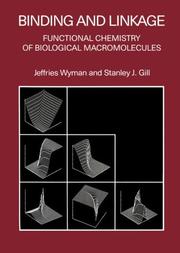
ISBN: 0935702563 9780935702569 Year: 1990 Publisher: University science books
Abstract | Keywords | Export | Availability | Bookmark
 Loading...
Loading...Choose an application
- Reference Manager
- EndNote
- RefWorks (Direct export to RefWorks)
Ligand binding (Biochemistry) --- Biochemie: chemische bindingen --- Binding, Ligand (Biochemistry) --- Biochemistry --- Dye-ligand affinity chromatography --- Radioligand assay --- Ligands (biochimie) --- Fixation --- Fixation.
Book
ISBN: 1789231833 1789231825 1838813195 Year: 2018 Publisher: IntechOpen
Abstract | Keywords | Export | Availability | Bookmark
 Loading...
Loading...Choose an application
- Reference Manager
- EndNote
- RefWorks (Direct export to RefWorks)
The book Ligand describes the diversity and versatility of ligands, covering structural features, donor-acceptor properties and secondary functions like molecular recognition. Moreover, this book also provides a comprehensive account on the applicability like catalysis, sensors, supramolecular assembly, photochemical property, bioinorganic chemistry, and so on. The advancement of fundamentals in ligand design and the control of physicochemical properties of coordination compounds has largely increased emphasis on understanding the structural and electronic features toward different perspectives in materials science. In this regard, this book has a special appeal to chemists, biologists and others. This book will be beneficial for the graduate students, teachers, researchers and other professionals who are interested to fortify and expand their knowledge in chemistry, biology, microbiology, biotechnology, materials science, environmental science and so on.
Ligand binding (Biochemistry) --- Binding, Ligand (Biochemistry) --- Biochemistry --- Dye-ligand affinity chromatography --- Radioligand assay --- Physical Sciences --- Engineering and Technology --- Chemistry --- Bioinorganic Chemistry --- Inorganic Chemistry
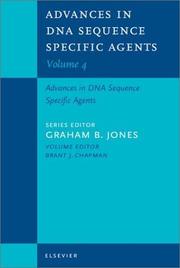
ISBN: 1281027340 9786611027346 0080526136 0444510966 9780080526133 9780444510969 Year: 2002 Publisher: Greenwich, CT : JAI Press,
Abstract | Keywords | Export | Availability | Bookmark
 Loading...
Loading...Choose an application
- Reference Manager
- EndNote
- RefWorks (Direct export to RefWorks)
This series encompasses design, synthesis, application, and analytical methods (including clinical and in vitro) for the study of these critical interactions. As our understanding of the genome and proteome expands, general developments in the field of DNA sequence specific interaction are likely to play an increasingly important role. Accordingly, manuscripts have been solicited from experts covering a diverse range of fields, reflecting the cross-disciplinary and dynamic nature of the series. Volume 4 describes work on the modification of DNA by AT specific anticancer drugs, DNA alky
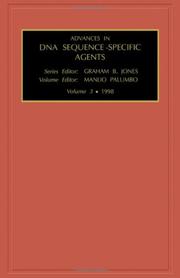
ISBN: 1281060127 9786611060121 008054455X 0762302038 9780762302031 Year: 1998 Publisher: Greenwich, CT : JAI Press,
Abstract | Keywords | Export | Availability | Bookmark
 Loading...
Loading...Choose an application
- Reference Manager
- EndNote
- RefWorks (Direct export to RefWorks)
In this volume the entire focus is devoted to the macromolecule target specificity of DNA interactive developmental therapeutic agents of current interest. A brief introduction to DNA interactive anticancer agents is included for readers who may benefit from an overview surrounding the developments that have contributed to our general understanding of this field. The following nine chapters have been carefully chosen so that they describe topics which are at the forefront of development in DNA-targeted cancer chemotherapy. Issues that have been addressed include the mechanisms of selective
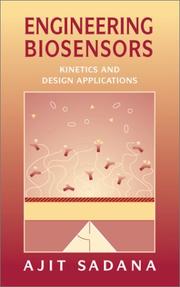
ISBN: 0126137633 9786611119331 1281119334 0080523633 9780080523637 9780126137637 6611119337 Year: 2002 Publisher: San Diego Academic Press
Abstract | Keywords | Export | Availability | Bookmark
 Loading...
Loading...Choose an application
- Reference Manager
- EndNote
- RefWorks (Direct export to RefWorks)
Biosensors are becoming increasingly important bioanalytical tools in the pharmaceutical, biotechnology, food, and other consumer oriented industries. The technology, though well developed in Europe, is slowly developing and has begun to generate interest in the United States only over the past couple of years. Research is now being directed toward the development of biosensors that are versatile, economical, and simple to use. Engineering Biosensors is a comprehensive introduction to biosensors that includes numerous illustrations to further explain the main concepts and practical exa
Biosensors. --- Ligand binding (Biochemistry). --- Basic Sciences. Biotechnology --- Biotechnology (General). --- Engineering --- Electronics --- Ligand binding (Biochemistry) --- Binding, Ligand (Biochemistry) --- Biochemistry --- Dye-ligand affinity chromatography --- Radioligand assay --- Biodetectors --- Biological detectors --- Biological sensors --- Biomedical detectors --- Biomedical sensors --- Detectors --- Medical instruments and apparatus --- Physiological apparatus
Book
ISSN: 15714853 ISBN: 9400752857 9400752849 9401782849 Year: 2013 Volume: v. 8 Publisher: Dordrecht : Springer,
Abstract | Keywords | Export | Availability | Bookmark
 Loading...
Loading...Choose an application
- Reference Manager
- EndNote
- RefWorks (Direct export to RefWorks)
This volume presents a review of the latest numerical techniques used to identify ligand binding and protein complexation sites. It should be noted that there are many other theoretical studies devoted to predicting the activity of specific proteins and that useful protein data can be found in numerous databases. The aim of advanced computational techniques is to identify the active sites in specific proteins and moreover to suggest a generalized mechanism by which such protein-ligand (or protein-protein) interactions can be effected. Developing such tools is not an easy task – it requires extensive expertise in the area of molecular biology as well as a firm grasp of numerical modeling methods. Thus, it is often viewed as a prime candidate for interdisciplinary research.
Ligand binding (Biochemistry) --- Protein binding. --- Binding, Protein --- Binding, Ligand (Biochemistry) --- Polyamines. --- Protein Structure, Tertiary --- Databases, Protein --- Binding Sites --- Protein Interaction Domains and Motifs --- Data Mining --- Medicine. --- Biomedicine. --- Biomedicine general. --- Biochemistry --- Allosteric proteins --- Radioligand assay --- Dye-ligand affinity chromatography --- Clinical sciences --- Medical profession --- Human biology --- Life sciences --- Medical sciences --- Pathology --- Physicians --- Health Workforce --- Biomedicine, general.
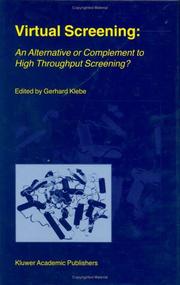
ISBN: 1280043458 9786610043453 0306468832 0792366336 Year: 2000 Publisher: Dordrecht, the Netherlands ; Boston, Massachusetts : Kluwer Academic Publishers,
Abstract | Keywords | Export | Availability | Bookmark
 Loading...
Loading...Choose an application
- Reference Manager
- EndNote
- RefWorks (Direct export to RefWorks)
In the next couple of years the human genome will be fully sequenced. This will provide us with the sequence and overall function of all human genes as well as the complete genome for many micro-organisms. Subsequently it is hoped, by means of powerful bioinformatic tools, to determine the gene variants that contribute to various multifactorial diseases and genes that exist in certain infectious agents but not humans. As a consequence, this will allow us to define the most appropriate levels for drug intervention. It can be expected that the number of potential drug targets will increase, possibly by a factor of 10 or more. Nevertheless, sequencing the human genome or, for that matter, the genome of other species will only be the starting point for the understanding of their biological function. Structural genomics is a likely follow-up, combined with new techniques to validate the therapeutic relevance of such newly discovered targets. Accordingly, it can be expected that in the near future we will witness a substantial increase in novel putative targets for drugs. To address these new targets effectively, we require new approaches and innovative tools. At present, two alternative, yet complementary, techniques are employed: experimental high-throughput screening (HTS) of large compound libraries, increasingly provided by combinatorial chemistry, and computational methods for virtual screening and de novo design. As kind of status report on the maturity of virtual screening as a technique in drug design, the first workshop on new approaches in drug design and discovery was held in March 1999, at Schloß Rauischholzhausen, near Marburg in Germany. More than 80 scientists gathered and discussed their experience with the different techniques. The speakers were invited to summarize their contributions together with their impressions on the present applicability of their approach. Several of the speakers followed this request which is summarized in this publication.
Drugs --- High throughput screening (Drug development) --- Ligand binding (Biochemistry) --- Design --- Computer simulation. --- Pharmacy. --- Chemistry. --- Computer Applications in Chemistry. --- Chemoinformatics. --- Chemical informatics --- Chemiinformatics --- Chemoinformatics --- Chemistry informatics --- Chemistry --- Information science --- Computational chemistry --- Medicine --- Materia medica --- Pharmacology --- Data processing --- High throughput testing (Drug development) --- HRS (Drug development) --- Drug development --- Pharmaceutical chemistry --- Binding, Ligand (Biochemistry) --- Biochemistry --- Dye-ligand affinity chromatography --- Radioligand assay --- Medicaments --- Medications --- Medicine (Drugs) --- Medicines (Drugs) --- Pharmaceuticals --- Prescription drugs --- Bioactive compounds --- Medical supplies --- Pharmacopoeias --- Chemotherapy --- Pharmacy
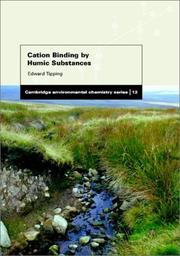
ISBN: 1107114802 1280429399 9786610429394 0511176600 0511039972 0511157495 0511329687 0511535597 0511050380 9780511039973 9780511535598 6610429391 0521621461 9780521621465 0521675650 9780521675659 Year: 2002 Publisher: Cambridge Cambridge university press
Abstract | Keywords | Export | Availability | Bookmark
 Loading...
Loading...Choose an application
- Reference Manager
- EndNote
- RefWorks (Direct export to RefWorks)
Humic substances are highly-abundant organic compounds formed in soils and sediments by the decay of dead plants, microbes and animals. This book focuses on the important binding properties of these compounds which regulate the chemical reactivity and bioavailability of hydrogen and metal ions in the natural environment. Topics covered include the physico-chemical properties of humic matter and interactions of protons and metal cations with weak acids and macromolecules. Experimental laboratory methods are also discussed, together with mathematical modelling. Finally the author looks at how the results of this research can be used to interpret environmental phenomena in soils, waters and sediments. This comprehensive account of cation binding by humic matter is a valuable resource for advanced undergraduate and graduate students, environmental scientists, ecologists and geochemists.
Humic acid --- Cations. --- Ligand binding (Biochemistry) --- Binding, Ligand (Biochemistry) --- Biochemistry --- Dye-ligand affinity chromatography --- Radioligand assay --- Positive ions --- Ions --- Organic acids --- Derivatives. --- Mathematical models. --- Cations --- 631.413.4 --- 631.416.8 --- 631.417.2 --- 631.417.2 Humus content --- Humus content --- 631.416.8 Metals and their compounds. Heavy metals in soil --- Metals and their compounds. Heavy metals in soil --- 631.413.4 Cation exchange --- Cation exchange --- Derivatives --- Mathematical models
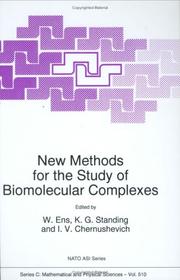
ISBN: 0792350030 9048150175 940159046X 9780792350033 Year: 1998 Volume: 510
Abstract | Keywords | Export | Availability | Bookmark
 Loading...
Loading...Choose an application
- Reference Manager
- EndNote
- RefWorks (Direct export to RefWorks)
A NATO Advanced Research Workshop entitled New Methods for the Study of Molecular Aggregates was held at Tbe Lodge at Kananaskis Village, Alberta, Canada from 16 -20 June 1996. In fact the meeting was entirely concerned with the problem of analyzing biomolecular complexes, so the title of these proceedings has been altered to give a more precise description of the content. Tbe workshop was hosted by the time-of-flight group of the Department of Physics at the University of Manitoba, and was attended by 64 participants from around the world. '!venty-one invited talks were given and 27 papers were presented as posters. Of the 48 contributions, 22 papers (12 orals, 10 posters) are included in these proceedings. Tbe subject of the conference was the investigation of noncovalent biomolecular complexes, with particular focus on the application of mass spectrometry to their characterization. '!vo new ionization techniques introduced in the late 1980s, electrospray ionization (ES I) and matrix-assisted laser desorptionlionization (MALDI), resulted in a breakthrough in mass spectrometry, enabling its use in molecular weight and primary structure determination of biopolymers larger than 100 kDa. Recently it has been discovered that ESI mass spectrometry mayaiso be used to characterize complexes containing noncovalent interactions, thus opening new perspectives for supramolecular chemistry. ESI mass spectrometry has the advantage that the sampie is introduced from a homogenous solution which can be maintained at near physiological conditions of pR, concentration, and temperature.
Ligand binding (Biochemistry) --- Biomolecules --- Complex chemicals --- Chemical ionization mass spectrometry --- Research --- Methodology --- Biochemistry. --- Analytical chemistry. --- Biochemistry, general. --- Analytical Chemistry. --- Analysis, Chemical --- Analytic chemistry --- Chemical analysis --- Chemistry, Analytic --- Chemistry --- Biological chemistry --- Chemical composition of organisms --- Organisms --- Physiological chemistry --- Biology --- Medical sciences --- Composition --- Chemical ionization mass spectrometry. --- Mass spectrometry. --- Biological molecules --- Molecules --- Molecular biology --- Mass spectra --- Mass spectrograph --- Mass spectroscopy --- Mass spectrum analysis --- Mass (Physics) --- Nuclear spectroscopy --- Spectrum analysis --- Mass spectrometry --- Binding, Ligand (Biochemistry) --- Biochemistry --- Dye-ligand affinity chromatography --- Radioligand assay --- Methodology. --- Ligand binding (Biochemistry) - Research - Methodology --- Biomolecules - Research - Methodology --- Complex chemicals - Research - Methodology
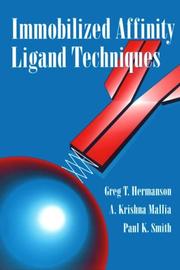
ISBN: 0123423309 Year: 1992 Publisher: San Diego (Calif.): Academic press
Abstract | Keywords | Export | Availability | Bookmark
 Loading...
Loading...Choose an application
- Reference Manager
- EndNote
- RefWorks (Direct export to RefWorks)
This book is a practical guide to the preparation and use of immobilized affinity ligands for purification, catalysis, and analysis. Special emphasis is given to immunochemical techniques including antibody isolation, preparation of antibody fragments using immobilized enzymes, and immunoaffinity chromatography. The book provides easy-to-follow, well-tested protocols to allow the uninitiated to use these techniques to the maximum advantage with minimum hassle. In addition, it shows researchers how to save money by making their own optimized affinity supports. Key Features * Matrix activation * Ligand immobilization * Binding and elution of target molecules * Enzyme catalysis on solid supports * Analytical affinity chromatography * Isolation/purification of antibodies * Preparation of antibody fragments * Immunoaffinity chromatography * Immobilization of nucleic acids * Use of immobilized ligands for removal of trace contaminants Practical advice on choosing: * Matrices * Spacers * Methods of activation and coupling Background information and insights on: * Affinity interactions * The ease and power of affinity chromatography * Attaching molecules to insoluble supports * Matrices currently in use * Over 20 methods of activation * Spacers * Extensive References
Chromatography, Affinity. --- Ligands. --- Protein Binding. --- Affinity chromatography --- Immobilized ligands (Biochemistry) --- Immunoadsorption --- Ligand binding (Biochemistry) --- Binding, Ligand (Biochemistry) --- Biochemistry --- Dye-ligand affinity chromatography --- Radioligand assay --- Adsorption (Biology) --- Antigen-antibody reactions --- Immunochemistry --- Ligands (Biochemistry) --- Chromatographic analysis --- Affinity Chromatography --- Bioaffinity Chromatography --- Chromatography, Bioaffinity --- Affinity chromatography. --- Immunoadsorption. --- Basic Sciences. Biology --- Biological Techniques --- Immobilized ligands (Biochemistry). --- Ligand binding (Biochemistry). --- Biological Techniques. --- Chromatography, Affinity --- Ligands --- Protein Binding --- Immunochromatography --- BIOCHEMISTRY --- immunoadsorption --- ligand binding --- immobilized ligands --- Monograph --- Biochemistry. --- Biological chemistry --- Chemical composition of organisms --- Organisms --- Physiological chemistry --- Biology --- Chemistry --- Medical sciences --- Composition --- Ligand --- Plasma Protein Binding Capacity --- Binding, Protein --- Binding Sites --- Blood Proteins --- Protein Interaction Mapping
| Listing 1 - 10 of 17 | << page >> |
Sort by
|

 Search
Search Feedback
Feedback About UniCat
About UniCat  Help
Help News
News